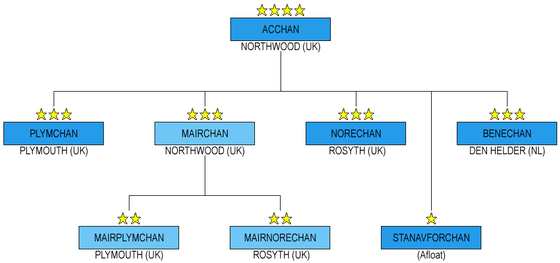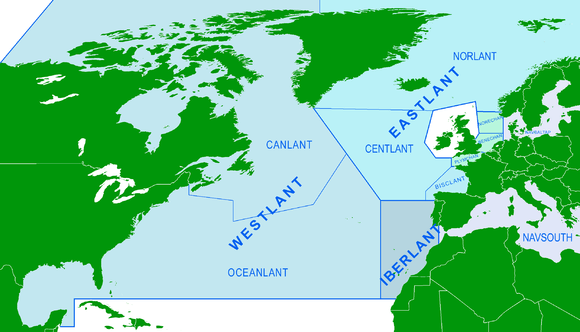Allied Command Channel
Allied Command Channel (ACCHAN) was one of three major North Atlantic Treaty Organization (NATO) commands. ACCHAN was activated in 1952 and disbanded in 1994.
History
Allied Command Channel was established in 1952 to defend the sea areas, including allied shipping, around the English Channel. In case of war with the Warsaw Pact American reinforcements, crucial to defeat a Soviet advance towards the Rhine, would have passed through the English Channel and disembarked mainly in the ports of Antwerp and Rotterdam. Therefore ACCHAN's area of operations included most of the Southern part of the North Sea and all of the Channel up to the Celtic Sea.[1]
Structure


At the end of the Cold War ACCHAN had the following structure:
- Allied Command Channel (ACCHAN), in Northwood, United Kingdom[2]
- Nore Sub-Area Channel Command (NORECHAN), in Pitreavie, United Kingdom
- Plymouth Sub-Area Channel Command (PLYMCHAN), in Plymouth, United Kingdom
- Benelux Sub-Area Channel Command (BENECHAN), in Den Helder, Netherlands
- Allied Maritime Air Force Channel (AIRCHAN), in Northwood, United Kingdom
- Maritime Air Nore Sub-Area Channel Command (AIRNORECHAN), in Pitreavie, United Kingdom
- Maritime Air Plymouth Sub-Area Channel Command (AIRPLYMCHAN), in Plymouth, United Kingdom
- Standing Naval Force Channel (STANAVFORCHAN), afloat
Allied Command Channel
The Commander-in-Chief, Allied Command Channel (CINCHAN) was a British admiral, who reported directly to the NATO Military Committee's Standing Group and was identified as a "Major NATO Commander" (like SACEUR and Supreme Allied Commander Atlantic (SACLANT).[1][3] CINCHAN double hatted as follows:
- 1952-1966 Commander-in-Chief, Portsmouth[4][5]
- 1966-1971 Commander-in-Chief British Western Fleet (who was also NATO Commander-in-Chief Eastern Atlantic)[6]
- 1971-1994 Commander-in-Chief Fleet (who was also NATO Commander-in-Chief Eastern Atlantic)
Allied Command Channel was based initially at Portsmouth, but in 1966 the command moved to Northwood, where the Commander-in-Chief Eastern Atlantic (CINCEASTLANT) was based.[7] On 1 July 1994, the Channel Command was disestablished: however most of its subordinate commands remained in existence although reshuffled: most of the headquarters were absorbed within Allied Command Europe particularly as part of the new Allied Forces Northwestern Europe.[8]A Channel Committee consisting of the naval Chiefs-of-Staff of Belgium, the Netherlands and the United Kingdom served as an advisory and consultative body to the Commander-in-Chief, Channel.[3]
Nore Sub-Area Channel Command
The Nore Sub-Area Channel Command (NORECHAN) was a command based at Pitreavie Castle in Rosyth in Scotland. NORECHAN's task was to prevent Soviet Navy ship and submarines from passing through the Northern North Sea toward allied shipping routes in the English Channel and Southern North Sea. Therefore NORECHAN had a large number of anti-submarine warships at its disposal. The commander of NORECHAN was a Royal Navy Vice Admiral and double hatted as follows:
- 1952-1961 Commander-in-Chief, The Nore
- 1961-1994 Flag Officer Scotland & Northern Ireland
Plymouth Sub-Area Channel Command
The Plymouth Sub-Area Channel Command (PLYMCHAN) was a command based at Admiralty House in Plymouth. As the Eastern approaches to the English Channel were defended by NORECHAN and BENECHAN, PLYMCHAN's task was to prevent Soviet Navy submarines from entering the Western side of the channel. Therefore PLYMCHAN had a large number of anti-submarine warships at its disposal, which would operate where Channel and Atlantic Ocean intersect. PLYMCHAN would have operated alongside the French Navy, which was not integrated into NATO's command structures.
The commander of PLYMCHAN was a Royal Navy Vice Admiral and double hatted as follows:
- 1952-1969 Commander-in-Chief, Plymouth
- 1969-1994 Commander-in-Chief, Naval Home Command
Benelux Sub-Area Channel Command
The Benelux Sub-Area Channel Command (BENECHAN) was a joint Dutch-Belgian command based in Den Helder tasked with the defense of the southern part of the North Sea from the Strait of Dover to the Ems estuary. In case of war the entire Belgian Naval Force, the Home Fleet of the Royal Netherlands Navy would come under its command.[9]
BENECHAN's commanding officer was the Commanding Admiral of the Netherlands Home Fleet, while Belgium's Commander Naval Operations served as Chief of Staff. The combined Dutch and Belgian staff at Den Helder in the Netherlands was tasked with ensuring that the approach, coastal, and entrance channels to Belgian and Netherlands' ports were always open for allied shipping. As ACCHAN's other two sub-commands PLYMCHAN (Plymouth Sub-Area Channel Command) and NORECHAN (Nore Sub-Area Channel Command) defended the direct approaches to the Belgian and Dutch coast via the English channel and the North Sea and as BALTAP's German-Danish Allied Naval Forces Baltic Approaches Command (COMNAVBALTAP) kept the Soviet Baltic Fleet bottled up in the Baltic Sea, the main risk for allied shipping in the BENECHAN area of operations were air and submarine dropped Soviet naval mines.
After the end of the Cold War BENECHAN became the Dutch-Belgian bi-national command Admiral Benelux in Den Helder.
Allied Maritime Air Force Channel
Allied Maritime Air Force Command (MAIRCHAN) was based at Northwood Headquarters and its commander was the Royal Air Force Air Marshal commanding No. 18 (Maritime) Group. This Air Marshal was also the Commander Maritime Air Eastern Atlantic (MAIREASTLANT) under CinC, Eastern Atlantic (EASTLANT), which was a command subordinate to Supreme Allied Commander Atlantic (SACLANT).
In case of war the following units would be under MAIRCHAN. Allied reinforcements flying from bases or operating in the area of MAIRCHAN would also have come under its control:
- Allied Maritime Air Force Channel - No. 18 (Maritime) Group[10]
- Maritime Air Nore Sub-Area Channel Command (MAIRNORECHAN) based at Pitreavie Castle in Rosyth
- RAF Kinloss
- No. 120 Squadron RAF Squadron with 8x Nimrod MR.2 maritime patrol aircraft
- No. 201 Squadron RAF Squadron with 8x Nimrod MR.2 maritime patrol aircraft
- No. 206 Squadron RAF Squadron with 8x Nimrod MR.2 maritime patrol aircraft
- RAF Lossiemouth
- No. 8 Squadron RAF Squadron with 12x Avro Shackleton AEW.2s airborne early warning aircraft
- No. 12 Squadron RAF Squadron with 12x Buccaneer S.2B attack aircraftnote 1
- No. 208 Squadron RAF Squadron with 12x Buccaneer S.2B attack aircraftnote 1
- No. 237 Operational Conversion Unit RAF with 16x Buccaneer S.2B attack aircraft
- RAF Kinloss
- Maritime Air Plymouth Sub-Area Channel Command (MAIRPLYMCHAN) based in Plymouth
- RAF St Mawgan
- No. 42 Squadron RAF Squadron with 8x Nimrod MR.2 maritime patrol aircraft
- No. 236 Operational Conversion Unit RAF 3x with Nimrod MR.2 maritime patrol aircraft
- RAF Wyton
- No. 51 Squadron RAF Squadron with 3x Nimrod R.1 signals intelligence aircraft
- No. 100 Squadron RAF Squadron with 12x Canberra T.17 electronic warfare training aircraft
- No. 360 Squadron RAF Squadron with 12x Canberra electronic warfare training aircraft
- No. 231 Operational Conversion Unit RAF with Canberra medium bombers
- Netherlands Naval Aviation Service - Valkenburg Naval Air Base, Netherlands
- No. 320 Squadron MLD with 6x P-3 Orion maritime patrol aircraft
- No. 321 Squadron MLD with 6x P-3 Orion maritime patrol aircraft
- Training Flight with 1x P-3 Orion maritime patrol aircraft
- RAF St Mawgan
- Maritime Air Nore Sub-Area Channel Command (MAIRNORECHAN) based at Pitreavie Castle in Rosyth
Note 1: Unit had a nuclear strike role and had twelve British WE.177 tactical nuclear bombs.
Standing Naval Force Channel
Standing Naval Force Channel (STANAVFORCHAN), activated on May 11, 1973 as an active mine countermeasure squadron directly under the command of CINCHAN. The squadron was tasked with the protection of the English Channel and the Southern North Sea. STANAVFORCHAN consisted of seven to nine mine countermeasure vessels from the Royal Navy, German Navy, Royal Netherlands Navy and Belgian Naval Force, which were assigned to the squadron for either six or twelve months. The command of the squadron rotated between the participating countries, with the exception of Germany. As the squadron had no homeport it spent most time afloat or on port visits in allied nations.[11]
STANAVFORCHAN continuously trained mine clearance and allied cooperation to ensure that in case of war the four allied nations would be able to defuse Soviet mines dropped by airplane or submarine in their area of operations rapidly. In 2000 STANAVFORCHAN changed name and composition when the Royal Danish Navy and Royal Norwegian Navy joined the squadron. Today the unit is named Standing NATO Mine Countermeasures Group 1.
References
- 1 2 Pedlow, Dr. Gregory W. "The Evolution of NATO's Command Structure, 1951-2009" (PDF). Retrieved 24 April 2016.
- ↑ Gregory, Shaun (1996). Nuclear Command and Control in NATO: Nuclear Weapons Operations and the Strategy of Flexible Response. London: MacMillan Press. p. 60-61. ISBN 978-1-349-39607-8.
- 1 2 "NATO Handbook". 25 March 1993.
- ↑ "Chapter 7 - The Military Structure - Channel Command and Channel Committee". NATO the first five years 1949-1954. NATO. Retrieved 2008-09-03.
- ↑ "Appendix 1 — Chronicle". NATO the first five years 1949-1954. NATO. Retrieved 2008-09-03.
- ↑ "History of SNMMG1 (formerly MCMFORNORTH])". Allied Maritime Component Command Headquarters Northwood. Retrieved 29 May 2008.
- ↑ "History of the Northwood site". Ministry of Defence. Retrieved 25 April 2016.
- ↑ Young, Thomas-Durrell (1 June 1997). "Command in NATO After the Cold War: Alliance, National, and Multinational Considerations". U.S. Army Strategic Studies Institute. p. 11. Retrieved 26 April 2016.
- ↑ Mooney, Thomas (March 1979). The Belgian Navy (Thesis). Monterey, California: Naval Postgraduate School.
- ↑ Isby and Kamps 1985, p. 313.
- ↑ Mooney, Thomas (March 1979). The Belgian Navy (Thesis). Monterey, California: Naval Postgraduate School.